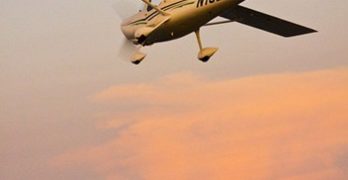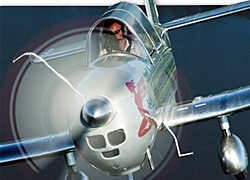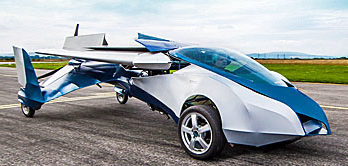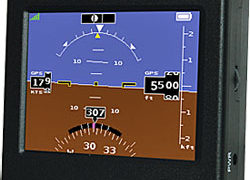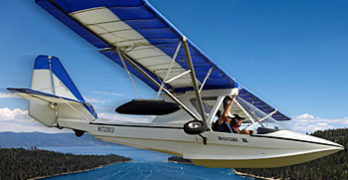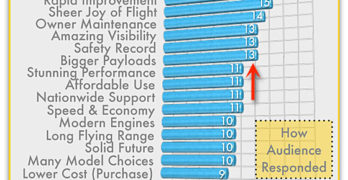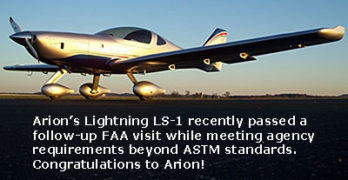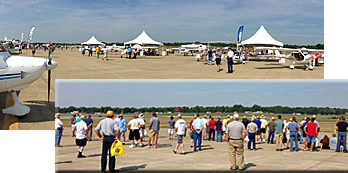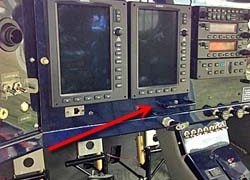*** A story posted by Daniel McCoy, a reporter for the Wichita Business Journal, claims the star-crossed Cessna 162 Skycatcher will likely not enjoy the longevity and success of other notable Cessna icons such as the C-172 and C-150/152. *** The Skycatcher was one of the first SLSA out of the gate for the new category created by FAA in 2004. But troubles with manufacturing and two highly publicized airframe parachute deployments during flight testing, including an airframe redesign after the first one, contributed to the dark cloud that seemed to follow the once-bright promise of Cessna’s entry. *** The market-perceived lackluster specifications sheet and barebones/industrial interior finish relative to many other LSA entries also contributed to the steady attrition in the once-1000-plus order sheet for the Skycatcher. *** The news came yesterday at the NBAA (National Business Aviation Association) confab in Las Vegas. Company CEO Scott Ernest made the remark that Skycatcher had difficulty attracting market share and had lost a sizable percentage of its multi-year back orders.
Search Results for : flight design ct
Not finding exactly what you expected? Try our advanced search option.
Select a manufacturer to go straight to all our content about that manufacturer.
Select an aircraft model to go straight to all our content about that model.
Flying Sam; “A Warbird for the LSA Market”
To some it’s a new entry in the LSA race (Sam LS is presently selling kits while pursuing SLSA acceptance). To others the Canadian LSA is a “mini T-6” or a “mini Yak 52.” Either characterization no doubt pleases designer Thierry Zibi. During development he did a thorough job of asking airshow visitors what appealed to them. Now that Sam is flying, it is fair to say that even with the availability of 132 other Light-Sport Aircraft models, Sam LS is unique. At AOPA’s last-ever Summit event in Fort Worth, Texas, I got a chance to take Sam aloft with Thierry overseeing from the aft seat. Short tell: it may look like a miniature warbird, but flies with very solid and pleasant qualities.
As the sun-drenched photos reveal, Thierry’s airplane glistens with polished aluminum, an uncommon appearance on airport ramps loaded with brightly painted aircraft accented with jaunty striping.
Sleek & Unique: Stefan Klein’s Aeromobil
After watching the Terrafugia Transition (video) fly from on the main airshow runway at AirVenture 2013, many pilots began to view the LSA flying car as more than a media magnet. The project, which has indeed generated an amazing amount of mainstream media attention, proved itself to be a real aircraft that can indeed drive like a car. More recently the Massachusetts company amped up their game with a new model, TF-X, now in early design stage. Meanwhile, the Transition, also evolving as a design, garnered the attention of — and a $2.7 million investment from — DARPA, the U.S. government’s Defense Advanced Research Products Agency. Where some once saw a novelty product only of interest to those intrigued by a “flying car,” more began to view this as a genuine aircraft. However, Terrafugia isn’t the only company pursuing such a unique machine.
One of my favorite quotes comes from Molt Taylor, the prime mover behind Aerocar, perhaps the first “practical” flying car and one that earned certification.
Are You D2?…Tiny Instruments from Dynon & Garmin
An amazing thing happened as we all prepared to go to AOPA last-ever annual show in the sprawling Dallas-Fort Worth metroplex. Two top suppliers to the LSA sector came out with products bearing almost the same name. However, they’re quite different, fun, and well, yes … surprisingly practical. So, are you D2? Even the Star Wars robot of a similar sounding name might have desired these gizmos, neither of which were remotely possible back in the late 1970s when that movie franchise began.
Dynon’s D2 — The maker of the ubiquitous SkyView glass panels installed in so many higher end LSA has a smaller product that sells well in the GA world, where non-certified equipment cannot be mounted with FAA approval. So, just stick a D1 to the windscreen and you get a mini-Dynon panel for your older, round-gauges aircraft. Now, Dynon has introduced the D2, a second model to what they call their “Pocket Panel product line.” D2 adds WiFi connectivity to allow flight data to be sent to iPad, smartphone, and tablet aviation applications, and has a second screen with a G-Meter (photo).
LSA Seaplane Companies Cluster in Central Florida
Icon Aircraft receives a high percentage of the attention paid to LSA seaplanes. They’ve worked hard on marketing and been quite successful; their Facebook page has nearly 300,000 “Likes!” Yet, as I’ve written, this is a growing subset within the LSA industry with several interesting designs already flying plus new ones to come that are really going to widen people’s eyes. However, some of that remains in the future while we have present-day success stories. If you want a seaplane you can afford and you want it soon, you have several choices, for example: Progressive Aerodyne’s SeaRey and the hot little SeaMax, both of which are SLSA approved, plus Edra Aeronautica’s Super Petrel LS, and in the world of light kits, don’t forget another longtime player, Aero Adventure. The latter Florida company recently reported news.
“Here We Come Tavares,” exclaimed a recent newsletter from Aero Adventure!
Survey Results for Reasons to Buy LSA
At the Midwest LSA Expo that concluded a few days back, I delivered a presentation called “20+ Reasons to Buy an LSA.” However, to handle the subject a little bit differently, I turned it into an audience participation exercise. As I presented each slide of one particular reason, I explained what was meant and elaborated on how each reason made LSA different from other sorts of aircraft someone might consider buying. Then, I asked the audience to raise their hand if that reason was one that might cause them to buy a Light-Sport. I advised that no one was recording their names, so they remained anonymous. Each person could raise their hand as many times as they wanted or never raise their hand if they chose. No one had to participate. About 35 people listened and somewhere between 15 and 25 answered most of the time. The following chart shows the responses.
Simple Aircraft (Like LSA) Need Simple Rules
In this post I’m going to do something potentially risky. I am going to make some statements about the politics of aircraft certification. While rather dull, this subject is nonetheless something pilots and others feel rather strongly about as the safety of aircraft — for persons in or under aircraft — is involved. Doesn’t everyone except a handful of thrill seekers care deeply about safety? I certainly do yet I feel it’s time for some new directions. I fully expect not everyone will agree, but I feel strongly that these statements need to be made. So, here goes …
My term as Membership Secretary of ASTM’s F37 LSA committee will complete later this year; I will be term limited out. That’s perfectly fine … I’ve done my duty for several years. ASTM’s F37 committee is the group that wrote and updates the standards used to gain acceptance for Light-Sport Aircraft. F37 is populated by some exceptional people that are largely unsung heroes for all the hard work they’ve done with little recognition.
Best Midwest LSA Expo Yet? … Yes, Sir!
I reported earlier that it might have been the best AirVenture ever (thanks to the most pleasant weather I can recall in many years). Employing that yardstick, the just-concluded Midwest LSA Expo was equally successful. The fifth annual event in Mt. Vernon, Illinois — described by airport manager and principal organizer Chris Collins as “the little brother to the Sebring LSA Expo” — enjoyed three days of highly accommodating weather. Warm temperatures, mild winds, a solid turnout of LSA vendors, a few attractions such as the Maid in the Shade B-25, the “Red Nose” P-51 Mustang that made several high-speed performances (both offered rides, too), along with riveting demonstrations of John Snider‘s exceptional
Mosquito XET turbine-powered single place helicopter … brought out good crowds with Saturday looking especially strong.
In a closing interview with Collins, he reported Thursday was the best opening day they’ve ever had and that day was just a warm up.
Oshkosh 2013 Elements, Part 3: Slide-Out Panel
Elements are basic components of nature. As in our first two parts, I see Oshkosh Elements as worthy ideas other than airframes or engines. One such is World Aircraft Company‘s roller-bearing pull-out drawer instrument panel. Now, if you are like me and don’t spend a lot of time around your airplane with a wrench or soldering iron in your hands, you might not see why this is important. For panels with a collection of round instruments, maybe it isn’t as fetching an idea. Yet I’m willing to guess that nearly every mechanic who reads this or hears of World’s innovation is going to say, “Yes! Why hasn’t this been done before and why aren’t all instrument panels done this way?”
Early this year, I watched while two avionics mechanics maneuvered around the instrument panel in a Flight Design CTLSi. Their task was to install ADS-B hardware to coordinate with the dual-screen Dynon SkyView that fills left and right bays of the instrument panel.
SD-1 Minisport: the First SLSA Single Seater?
We looked at this airplane at AirVenture Oshkosh 2012 (video). At that time the Orem, Utah team presented their wood and composite airplane as a kit. In a year a lot changed and now SkyCraft is pushing ahead with plans for a Special LSA that will be delivered fully built for the modest price of $54,850. CEO Tyler Ives says the company is ready to declare compliance to ASTM standards and after they get a chance to prove that to FAA, the SD-1 Minisport might become the very first single seat Special Light-Sport Aircraft, a distinction that once earned will last forever. The only other candidate presently known is the Tecnam Snap aerobatic LSA. Given that Tecnam has achieved more LSA models than any other company, you should never count them out so the race is on to be the first-ever single seat SLSA.
- « Previous Page
- 1
- …
- 89
- 90
- 91
- 92
- 93
- …
- 145
- Next Page »


